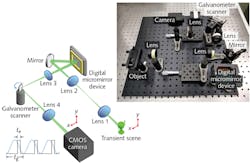Traditional cameras reach ultra-high imaging speeds with COSUP
A new method from researchers at the Institut National de la Recherche Scientifique (INRS; Varennes, QC, Canada) called single-shot compressed optical-streaking ultra-high-speed photography (COSUP) can increase the imaging speeds for traditional CMOS and CCD cameras by four orders of magnitude. Ultrahigh-imaging speeds of 1.5 million frames per second (fps) with a sequence depth of 500 frames and 0.5 megapixels (1000 × 500 pixels) per frame have been verified through high-speed imaging of a fast-moving ball and laser pulses.
Because traditional imaging techniques fall short of achieving ultrahigh speeds and high pixel counts, COSUP is instead implemented by first imaging a transient scene onto a digital micromirror device (DMD) loaded with a binary pseudorandom pattern (with an encoding pixel size of 32.4 µm2) to create spatially encoded frames that are then relayed onto a CMOS camera by 4f imaging optics. Placing a galvanometer scanner at the Fourier plane of the 4f system temporally shears the images so that the CMOS camera records the spatially encoded, temporally sheared scene as a 2D single-exposure streak image. Linear temporal shearing is accomplished by tuning the sinusoidal function of the galvo scanner to synchronize with the CMOS camera exposure time. A compressed-sensing-based reconstructed algorithm is used to retrieve the transient scene from the acquired streak image. Reference: X. Liu et al., Opt. Lett., 44, 6, 1387–1390 (2019).

Gail Overton | Senior Editor (2004-2020)
Gail has more than 30 years of engineering, marketing, product management, and editorial experience in the photonics and optical communications industry. Before joining the staff at Laser Focus World in 2004, she held many product management and product marketing roles in the fiber-optics industry, most notably at Hughes (El Segundo, CA), GTE Labs (Waltham, MA), Corning (Corning, NY), Photon Kinetics (Beaverton, OR), and Newport Corporation (Irvine, CA). During her marketing career, Gail published articles in WDM Solutions and Sensors magazine and traveled internationally to conduct product and sales training. Gail received her BS degree in physics, with an emphasis in optics, from San Diego State University in San Diego, CA in May 1986.
